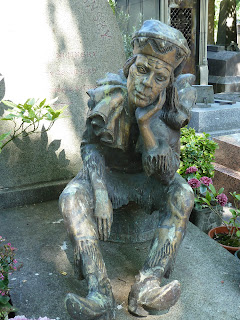The most interesting tidbit of information that I picked up at the Paris genealogy conference related to Jews in Scotland. In one of the sessions I learned that the original Jews in Scotland came as teachers and students. They came because unlike England, Scotland did not require students to take a Christian oath. I have a family branch that seemed to move between Glasgow and London and I am wondering if this factor might have something to do with those movements. I feel a trip to Scotland in my future.
The conference presented some challenges that are inherent in any truly international conference. Most revolved around language and reminded me of how as Americans we are very accustom to the rest of the world accommodating us by speaking English. One day I attended a film only to learn that it was in Polish with French subtitles. Then I went to a lecture that was in French, but had no translation available although for most sessions they did provide translation. At that point I threw up my hands and decided to take advantage of a rare sunny day in Paris and do some exploring.

As a "good student" I am not much good at cutting classes, but Paris beckoned and off I went to explore Montmartre. As previously noted, I am intrigued by cemeteries so after trekking through the small streets that surround Sacre Coeur, we did a stop at the Montmartre Cemetery. Interestingly the
highway bridge goes over the cemetery so as we walked across the bridge we could see through the metal lattice to the tombstones below. It appeared to have been measured carefully to just clear one particularly tall memorial. The cemetery was of an older vintage where many of the memorials were
in the form of a booth
the size of a telephone booth, essentially a small chapel. Pere Lachaise is similar in style while Montparnasse seemed somewhat more contemporary. Part of the intrigue of cemeteries is how they compress time so significant figures from different times can co-exist. Unlike Montparnasse Cemetery which had many artists and writers, there were far fewer names we recognized at Montmartre. We went in search of Degas and Gustav Moreau and found the de Gas family tomb and the bonus of Nijinsky who had an interesting sculpture atop his tomb. Gustav went undiscovered.
The following day we went out to explore the Marais, the old Jewish district and the more contemporary hip neighborhood that surrounds it.

The old Jewish district is largely concentrated around Rue de Rosier and Rue Vielle du Temple. The area is noteworthy for its plaques that detail the deportation of children from two of the neighborhood schools. I watched a diverse group of students gather in front of one of the schools as I thought about the tragic history that preceded them. The plaque noted that 260 Jewish students from that school had been deported to Germany during WWII. I have seen similar plaques at schools throughout the city. I wondered what these students knew of the events that had affected their predecessors. In a reflection of more current times, a plaque notes the terrorist grenade that killed several more recently at what used to be Goldenbergs. When I was here three years ago it still had the original awning, now it has become a clothing store. Yet another plaque speaks of the deportation of a family from their home. And yet life goes on in this district which is

still inhabited by many Jews. On the Rue de Rosiers is a synagogue that was designed by Guimand, the art nouveau designer of the metro stations.
Delis abound as do falafel stands.

Near this district is the Hotel de Ville where a show is currently up on the children who were deported. July 17th, the day prior to our visit, was the 70th anniversary of this event. Pictures of classes of students show a handful wearing yellow stars. What was most chilling were the teachers' record books which note the date the student enrolled, year of birth and then the notation "disparu", disappeared. A sign on a park notes that it is for children to play with the exception of Jewish children. The Vel d'hiv, the former site of cycle races, was used as the gathering place for families prior to deportation. This location has received far more attention with the release of the book and movie "Sarah's Key". Thirteen thousand people were crowded together with one toilet and virtually no food. There were 4000 children among them. The gathering place was a horrific indicator of what was to come. Perhaps most chilling was the fact that only French policemen were involved in the gathering of Jews at this site. It was done with great stealth with only one picture available as documentation of the buses gathered at the Vel d'Hiv. Of the 300,000 Jews who lived in France, 75,000 were deported.
With the conclusion of the conference and our Paris explorations, our next stop is the Isle de Re, a biking mecca across from La Rochelle.





I read Sarah's Key and recently watched the movie. It is a powerful story.
ReplyDelete